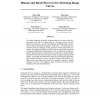Free Online Productivity Tools
i2Speak
i2Symbol
i2OCR
iTex2Img
iWeb2Print
iWeb2Shot
i2Type
iPdf2Split
iPdf2Merge
i2Bopomofo
i2Arabic
i2Style
i2Image
i2PDF
iLatex2Rtf
Sci2ools
NIPS
2003
2003
Human and Ideal Observers for Detecting Image Curves
This paper compares the ability of human observers to detect target image curves with that of an ideal observer. The target curves are sampled from a generative model which specifies (probabilistically) the geometry and local intensity properties of the curve. The ideal observer performs Bayesian inference on the generative model using MAP estimation. Varying the probability model for the curve geometry enables us investigate whether human performance is best for target curves that obey specific shape statistics, in particular those observed on natural shapes. Experiments are performed with data on both rectangular and hexagonal lattices. Our results show that human observers’ performance approaches that of the ideal observer and are, in general, closest to the ideal for conditions where the target curve tends to be straight or similar to natural statistics on curves. This suggests a bias of human observers towards straight curves and natural statistics.
| Added | 31 Oct 2010 |
| Updated | 31 Oct 2010 |
| Type | Conference |
| Year | 2003 |
| Where | NIPS |
| Authors | Alan L. Yuille, Fang Fang, Paul R. Schrater, Daniel Kersten |
Comments (0)

